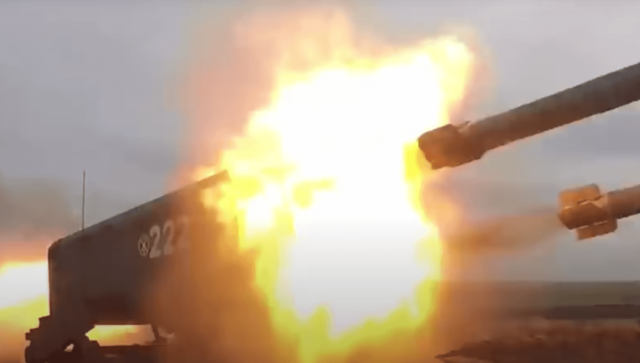
Russia admits using brutal thermobaric weapons in Ukraine, says UK A Russian TOS1-A thermobaric multiple launch rocket system firing rockets. (Screenshot)
The United Kingdom’s Ministry of Defence said on Wednesday that their Russian counterparts had confirmed the use of a rocket launcher that fires brutal thermobaric munitions in Ukraine.
U.K. Ministry of Defence tweeted, “The Russian MoD has confirmed the use of the TOS-1A weapon system in Ukraine. The TOS-1A uses thermobaric rockets, creating incendiary and blast effects. Watch the video below for more information about this weapon and its devastating impact.” The U.K. MoD also shared a video with pre-existing footage of the Russian multiple launch rocket system (MLRS) in use.
The Russian MoD has confirmed the use of the TOS-1A weapon system in Ukraine. The TOS-1A uses thermobaric rockets, creating incendiary and blast effects.
Watch the video below for more information about this weapon and its devastating impact.
🇺🇦 #StandWithUkraine🇺🇦 pic.twitter.com/d8PLQ0PhQD— Ministry of Defence 🇬🇧 (@DefenceHQ) March 9, 2022
Thermobaric weapons are particularly controversial because of how they deliver damage. The munitions create a mix of fuel and oxygen that creates a blast effect that lasts longer than conventional explosives. According to the U.S. Defense Intelligence Agency (DIA), these thermobaric explosives create a powerful pressure wave that causes a rarefaction or “vacuum” effect. This vacuum effect has led to some referring to thermobaric weapons as “vacuum bombs.”
The U.K.’s Ministry of Defence said the TOS-1A’s thermobaric munitions have a “devastating” effect that “can destroy infrastructure and cause significant damage to internal organs and flash burns, resulting in death to those exposed.”
Thermobaric weapons have been used by a number of countries, including Russia, the U.K. the U.S. The GBU-42/B, also known as the Mother of All Bombs (MOAB) is a thermobaric bomb that is considered the most powerful non-nuclear weapon in the U.S. arsenal.
The use of thermobaric munitions have been rumored throughout the last two weeks of Russia’s invasion of Ukraine. Some users on social media speculated that a particularly large blast near the Ukrainian city of Kharkiv was caused by one such thermobaric weapon.
Last week, when asked about Russia’s alleged use of so-called “vacuum bombs,” White House Press Secretary Jen Psaki said, “I don’t have any confirmation of that. We have seen the reports. If that were true, it would potentially be a war crime.”
While the U.K.’s MoD reported that it has Russian confirmation of the use of thermobaric weapons, the U.S. Department of Defense has not yet shared that assessment. During a Wednesday press briefing, Pentagon Press Secretary John Kirby was asked about Russia’s alleged use of such weapons and replied, “no indications that thermobaric weapons — no evidence of that that I can speak to.”
While the U.S. DoD has not confirmed Russia’s use of thermobaric weapons House Speaker Nancy Pelosi (D-CA) said she discussed the issue with Ukrainian President Volodymyr Zelenskyy in a Wednesday phone call.
“We talked about weapons that Putin is using, weapons prohibited in the Geneva Conventions, including cluster bombs and vacuum bombs, which caused severe suffering,” Pelosi told reporters, as Fox News reported.
The Geneva Conventions, which actually consist of four treaties and three protocols, does not specifically ban thermobaric weapons, however, the conventions do constrain the uses of force in war times. The Convention on Certain Conventional Weapons, also does not specifically ban thermobaric weapons but does seek the prohibition of weapons “which may be deemed to be excessively injurious or to have indiscriminate effects.”
Human Rights Watch is one particular group that has argued thermobaric bombs could be considered banned weapons, especially when used near highly populated civilian areas. The organization told Fox News that thermobaric bombs are “prone to indiscriminate use” due to their large blast radius.
“In urban settings it is very difficult to limit the effect of enhanced blast weapons to combatants,” Human Rights Watch added. “And the nature of enhanced blast weapons makes it virtually impossible for civilians to take shelter from their destructive effect.”




